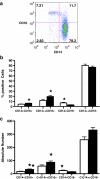Impaired functions of peripheral blood monocyte subpopulations in aged humans
- PMID: 20703784
- PMCID: PMC2970801
- DOI: 10.1007/s10875-010-9448-8
Impaired functions of peripheral blood monocyte subpopulations in aged humans
Abstract
Aging is associated with increased susceptibility to microbial infections, and monocytes play an important role in microbial defense. In this study, we have identified and compared four subpopulations of monocytes (CD14(++(high))CD16(-), CD14(+(low))CD16(-), CD14(++(high))CD16(+), and CD14(+(low))CD16(+)) in the peripheral blood of young and aged subjects with regard to their numbers, cytokine production, TLR expression, and phosphorylation of ERK1/2 in response to pam3Cys a TLR-1/2 ligand. Proportions and numbers of CD14(++(high))CD16(+) and CD14(+(low))CD16(+) monocytes were significantly increased, whereas proportions of CD14(+(low))CD16(-) monocytes were decreased in aged subjects as compared to young subjects. In aged subjects, IL-6 production by all four subsets of monocytes was significantly decreased, whereas TNF-α production was decreased in monocyte subsets, except the CD14(+(low))CD16(-) subset. A significantly reduced expression of TLR1 was observed in CD14(++(high))CD16(+) and CD14(+(low))CD16(+) monocyte subsets in aged subjects. Furthermore, following pam3Cys stimulation, ERK1/2 phosphorylation was significantly lower in CD14(+(low))CD16(+), CD14(++(high))CD16(+), and CD14(+(low))CD16(-) subsets of monocytes from aged subjects. This is the first study of four subpopulations of monocytes in aging, which demonstrates that their functions are differentially impaired with regard to the production of cytokines, expression of TLR, and signaling via the ERK-MAPK pathway. Finally, changes in the number of monocyte subsets, and impairment of TLR1 expression, TNF-α production, and EK1/2 phosphorylation was more consistent in CD16(+) monocyte subsets regardless of expression of CD14(high) or CD14(+low), therefore highlighting the significance of further subdivision of monocytes into four subpopulations.
Figures




Similar articles
-
Regulation of Toll-like receptor (TLR)2 and TLR4 on CD14dimCD16+ monocytes in response to sepsis-related antigens.Clin Exp Immunol. 2005 Aug;141(2):270-8. doi: 10.1111/j.1365-2249.2005.02839.x. Clin Exp Immunol. 2005. PMID: 15996191 Free PMC article.
-
Modulatory effects of CD14+CD16++ monocytes on CD14++CD16- monocytes: a possible explanation of monocyte alterations in systemic lupus erythematosus.Arthritis Rheumatol. 2014 Dec;66(12):3371-81. doi: 10.1002/art.38860. Arthritis Rheumatol. 2014. PMID: 25168844
-
Overexpression of TLR2 and TLR9 on monocyte subsets of active rheumatoid arthritis patients contributes to enhance responsiveness to TLR agonists.Arthritis Res Ther. 2016 Jan 13;18:10. doi: 10.1186/s13075-015-0901-1. Arthritis Res Ther. 2016. PMID: 26759164 Free PMC article.
-
Monocyte subpopulations and cardiovascular risk in chronic kidney disease.Nat Rev Nephrol. 2012 Mar 13;8(6):362-9. doi: 10.1038/nrneph.2012.41. Nat Rev Nephrol. 2012. PMID: 22410492 Review.
-
How toll-like receptors reveal monocyte plasticity: the cutting edge of antiinflammatory therapy.Cell Mol Life Sci. 2019 Feb;76(4):745-755. doi: 10.1007/s00018-018-2959-9. Epub 2018 Nov 9. Cell Mol Life Sci. 2019. PMID: 30413835 Free PMC article. Review.
Cited by
-
Frailty in old age is associated with decreased interleukin-12/23 production in response to toll-like receptor ligation.PLoS One. 2013 Jun 5;8(6):e65325. doi: 10.1371/journal.pone.0065325. Print 2013. PLoS One. 2013. PMID: 23755218 Free PMC article.
-
Cancer Vaccines: Adjuvant Potency, Importance of Age, Lifestyle, and Treatments.Front Immunol. 2021 Feb 17;11:615240. doi: 10.3389/fimmu.2020.615240. eCollection 2020. Front Immunol. 2021. PMID: 33679703 Free PMC article. Review.
-
The DARC Side of Inflamm-Aging: Duffy Antigen Receptor for Chemokines (DARC/ACKR1) as a Potential Biomarker of Aging, Immunosenescence, and Breast Oncogenesis among High-Risk Subpopulations.Cells. 2022 Nov 29;11(23):3818. doi: 10.3390/cells11233818. Cells. 2022. PMID: 36497078 Free PMC article. Review.
-
Smoking-, Alcohol-, and Age-Related Alterations of Blood Monocyte Subsets and Circulating CD4/CD8 T Cells in Head and Neck Cancer.Biology (Basel). 2022 Apr 25;11(5):658. doi: 10.3390/biology11050658. Biology (Basel). 2022. PMID: 35625386 Free PMC article.
-
Aging leads to dysfunctional innate immune responses to TLR2 and TLR4 agonists.Aging Clin Exp Res. 2019 Sep;31(9):1185-1193. doi: 10.1007/s40520-018-1064-0. Epub 2018 Nov 7. Aging Clin Exp Res. 2019. PMID: 30402800 Free PMC article.
References
Publication types
MeSH terms
Substances
LinkOut - more resources
Full Text Sources
Other Literature Sources
Medical
Research Materials
Miscellaneous

